Production And Propagation Of Waves SS2 Physics Lesson Note
Download Lesson NoteTopic: Production And Propagation Of Waves

A wave is a disturbance which travels through a medium transferring energy from one point to another without causing any permanent displacement of the medium.
A wave motion is the process of transferring a disturbance from one point to another without any transfer of particles of the medium.
TYPES OF WAVES
Waves are broadly classified into two types:
- Based on the medium of propagation: mechanical wave and electromagnetic wave
- Based on the comparison of the wave direction with the direction of vibration of the particle: transverse wave and longitudinal wave
Production And Propagation Of Waves: Based On The Medium Of Propagation
- Production and propagation of mechanical waves
A mechanical wave is a wave that requires a material medium for its mode of propagation (or for it to transfer energy away from the source). Examples are waves travelling through springs, water waves, and sound waves
2. Production and propagation of electromagnetic waves
Electromagnetic waves are waves that do not need a material medium for their mode of propagation (or for them to transfer energy away from the source). Examples are radio waves, visible light, ultraviolet rays, x-rays, and gamma rays. Electromagnetic waves travel at the speed of light (3.0×108m).
A wave which travels along a medium transferring energy from one part of the medium to another is called a progressive wave. The progressive wave can be divided into transverse and longitudinal waves.

Progressive or travelling wave
A standing or stationary wave: this is formed when two waves travelling in the opposite direction meet or by superimposition of an incident wave and its reflection. The amplitude of the standing wave varies along the wave.

Standing or stationary wave
- Production and Propagation of waves: Based on the comparison of the wave direction with the direction of vibration of the particle
i. Transverse waves
A transverse wave is a wave which travels perpendicularly to the direction of the vibrations producing the waves.

ii. Longitudinal wave
Longitudinal waves are waves which travel in a direction parallel to the vibrations of the medium.
TERMS USED IN DESCRIBING WAVES

- Phase – particles which are in the same vertical direction from their positions of rest and are moving in the same direction are said to be in phase.
- Cycle – is a complete to-and-fro movement or oscillation of a vibrating particle
- The amplitude (A) – is the maximum displacement of a particle from its rest or mean position. It is measured in meters (m).
- The period (T) – is the time required for a particle to perform one complete cycle or oscillation
f = 1/T ……1
T = 1/f …..2
- Frequency (f) – is the number of complete cycles made in one second. It is measured in Hertz (Hz)
- Wavelength (λ) – the distance covered by the waves after one complete oscillation. For transverse waves, it is the distance between successive crests or troughs while for longitudinal waves, it is the distance between successive compressions or rarefactions. It is measured in meters (m).
- Wave velocity (v) is the distance travelled by the waves in one second. The S.I unit is m/s
MATHEMATICAL RELATIONSHIP
V = wave-velocity
f = frequency (Hz)
λ = wavelength
T = Period (S¹)
V = f × λ
V = distance travelled by wave
corresponding time taken
V = λ/T
From eqn 1, f = 1/T
We have: v = λ/T
v = fλ
λ = vT
Worked example
A radio station broadcasts at a frequency of 300 KHz. If the speed of the wave is 3 x 108 ms-1, calculate the period and wavelength of the wave.
T = 1/f
T = 1/3300000
T = 3.3 × 10-⁶S
v = λ/T
v = 3×10⁸
3×10⁵
λ = 1000m
ASSIGNMENT
- What is wave motion?
(b) The equation represents a wave train in which y is the vertical displacement of a particle at a distance x from the origin in the medium through which the wave travels. Explain, with the aid of a diagram, what A and λ represent.
A radio wave transmitted from a certain radio station is represented by the wave equation:
- Calculate the (i) wavelength of the wave (ii) frequency of the wave (ii) velocity of the wave. Where x and y are in meters while t is in seconds






















